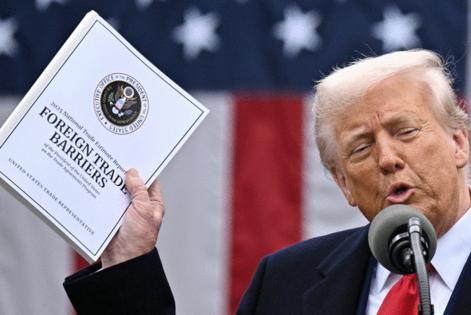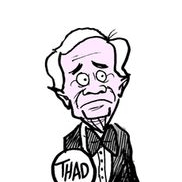Detroit Three fear foreign competitors will pay less in tariffs. Here's what the data show
Published in Automotive News
The Detroit Three automakers and the United Auto Workers have raised concerns about new U.S. tariff deals with Japan and the European Union, which include rates lower than those for Canada and Mexico. But federal data show duties paid on overall auto imports from the U.S. neighbors are less than the 15% rate President Donald Trump negotiated with Japan and the EU.
As Friday's tariff deadline approaches, Trump has suggested rates could change again and even increase on close trading partners such as Canada and Mexico. It also remains unclear whether U.S.-Mexico-Canada trade agreement exemptions will remain in place. With all of that in flux, Detroit automakers say imposing a lower import tax rate on Japan and the EU, where manufacturers aren't facing Trump's metals tariffs and have other benefits, will disadvantage the domestic industry.
"Japan does have substantial structural advantages and labor costs, materials, currency that do outweigh a 15% tariff," Ford Chief Financial Officer Sherry House said Wednesday on an earnings briefing call. "Ford is facing significant tariff costs on parts and materials for the vehicles that we build right here in the U.S."
The Detroit News analyzed the total tariffs paid for imports of motor vehicles and parts from certain countries divided by the total value of those imports. In May, that duty rate paid on motor vehicles imported from Mexico was 9.7% and from Canada was less than 0.1%, according to the latest data available from the U.S. Commerce Department through the International Trade Commission's DataWeb. For parts, it was 7% and 6.5%, respectively.
The Commerce Department's Census Bureau on Wednesday, however, posted on its website unpublished corrections to trade data that include vehicles and parts from Canada and Mexico. The changes, however, have not yet been reflected in the data published through the ITC.
These are known as ad valorem duty rates, and they provide a helpful picture of the tariffs actually being paid on imports from each country, though they don't specify the exact rate an individual company is paying on a specific vehicle or component. Those rates could be higher or lower based on exemptions and other factors that can affect required duties.
In late March, President Donald Trump raised tariffs on imports of vehicles and certain parts to 27.5%. Lowering the rate to 15% on imports from Japan and the European Union is set to benefit foreign automakers like Toyota Motor Corp. and Volkswagen AG, which last year imported about 50% and 80% of the vehicles they sold in the United States, according to financial information firm S&P Global Inc.
The duty rate of calculated duties over the customs value of motor vehicles imported from Japan in May was 29%, according to the federal data. For parts, it was 18%. For EU vehicle imports, the duty rate was 27%, and for parts, it was 15%.
An analysis by East Lansing's Anderson Economic Group found the difference between tariffs on Canada and Mexico and on Japan and Europe would mean a cost penalty of "thousands of dollars per vehicle" for numerous models assembled in the United States.
"It’s a justifiable concern for automakers to be complaining about that," said Stephanie Brinley, S&P's principal automotive analyst. "For 50 years and 34 years for Mexico, we’ve been building up supply chain infrastructure. Everybody playing in this market has been abiding by those rules. Everyone has worked to that standard, so at this point, to turn around and say, 'We’ve just decided that doesn’t matter anymore,' it's a big push on companies and the economy."
The UAW, in a statement, criticized the Japan deal as offering a break to foreign automakers without requiring higher standards for pay and benefits and the freedom to organize "without intimidation" for their workers.
Meanwhile, Matt Blunt — president of the American Automotive Policy Council, a trade group representing the interests of Ford Motor Co., General Motors Co. and Stellantis NV — in a statement on the Japan deal said the automakers were reviewing the agreement's details.
But he said: "Any deal that charges a lower tariff for Japanese imports with virtually no U.S. content than the tariff imposed on North American-built vehicles with high U.S. content is a bad deal for U.S. industry and U.S. auto workers."
U.S. Commerce Secretary Howard Lutnick last week balked at the idea that the Japan deal would disadvantage American manufacturers: "Oh, my God, that’s just so silly,” he told CNBC, saying he had spoken with leaders at U.S. auto companies earlier about the deal. "They are cool with it."
He added that if U.S. automakers are "a little bummed out" over Japan's tariffs decreasing, then they should move Canadian and Mexican production to the United States to avoid tariffs altogether. No vehicle assembled in the United States, however, uses only parts that originate here.
Globally in May, calculated duties represented 17% and 15% of the value of all imported motor vehicles and parts, respectively.
The AAPC declined comment beyond its earlier statement on the Japanese deal. GM, Ford and Chrysler parent Stellantis referred comment to the AAPC concerning the federal data.
It's no surprise that many importers are paying below 25% tariffs for vehicles as well as on parts from Canada and Mexico.
There are import tax exemptions related to compliance with the U.S.-Mexico-Canada trade agreement that cover the vast majority of automotive trade between the three countries. Compliant parts are exempt for now. On May 20, the government issued procedures by which companies could submit documentation identifying the amount of U.S. content in each vehicle that would be exempt from the tariff on motor vehicles from Canada and Mexico.
Items from Canada and Mexico that don't comply with USMCA face a 25% tariff, and Trump has threatened to raise rates even higher to 30% or 35% on Aug. 1. It's unclear whether the tariff hike would also come with an end to Trump's USMCA exemption. USMCA has a mandatory review of its rules scheduled for July 1, 2026.
"It’s not 25% straight across the board on everything," Brinley said. "There are still a lot of negotiations happening. This is what the situation is today, but I don't know what it is going to be in six months."
A less than 0.1% rate on vehicles from Canada, however, appears particularly low, especially since it's a slight decrease year-over-year from before Trump was in office. The assessed value of motor vehicles imported from Canada declined 17% from May 2024, resulting in a 65% decrease in calculated duties, according to the federal data.
In April, the month Trump's vehicle tariffs went into effect, calculated duties were 97% higher than in May — the duty rate of calculated duties over the customs value of motor vehicles imported from Canada was 2.9% for April.
"It’s very early in tariff land," said Glenn Stevens, executive director of MichAuto, the automotive arm of the Detroit Regional Chamber. "It’s still July. I don’t think we have near representative numbers. There’s been so many reductions, pauses and so many revisions. There are a lot of complicating factors that don’t make it a very clear picture."
There have been efforts to increase USMCA compliance by automakers and suppliers. Additionally, some automakers have slowed or stopped shipping vehicles to certain countries because of tariffs.
GM cited the trade environment in its decision to cut a shift at its truck plant in Oshawa, Ontario, and it increased pickup production in Fort Wayne, Indiana. Stellantis has cut production levels at plants in Canada and Mexico, too. Companies also have relied on existing inventories on dealer lots as they wait to see what happens with trade negotiations, but those stocks are dwindling.
South Korea, from where GM shipped about 15% of its U.S. sales last year, had a duty rate of calculated duties over the customs value of motor vehicles of 25% in May, according to the federal data. For parts, it was 19%. Higher tariffs are imposed on China. The rate in May for motor vehicles was 112%. For parts, it was 69%.
In May, Trump announced a trade deal with the United Kingdom that lowered tariffs on imported vehicles below a quota from there to 10%. He signed that deal in June. In May, the country's calculated duties over customs value of imported vehicles was 27%. For parts, it was 14%.
The concern in granting countries like Japan, Germany and Italy a lower import tax rate than other nations extends beyond U.S. companies facing higher tariffs on imports from other countries. Foreign manufacturers have other benefits, such as lower prices on aluminum and steel on which Trump has placed a 50% tariff; that has resulted in prices of domestically produced metals to increase too. A 50% tariff on copper takes effect Aug. 1.
Additionally, foreign manufacturers building in other countries don't face the tariffs on parts that manufacturers in the United States do. For example, a Japanese automaker can import a part from China for less cost than a company in the United States can.
“The question for us is: Do our companies (in Michigan and the automotive sector) have an outsized impact and particularly the suppliers have an outsized impact, and what does that do to our industry and our economy?” Stevens said. “We feel like that impact is happening.”
Ford Motor Co., which builds 80% of the vehicles it sells in the United States here, on Wednesday reported a $36 million net loss for the second quarter. Tariffs so far this year have cost the company roughly $1 billion.
The Dearborn automaker increased its estimated tariff exposure by half a billion dollars to $3 billion and expected it to affect annual adjusted operating profit by $2 billion after offsets like production volumes and pricing changes. Contributing to the increase are higher aluminum and steel tariffs and longer-than-expected duties put in place on Canada, Mexico and China in response to what Trump has characterized as a fentanyl crisis, CFO House said.
GM in May issued full-year guidance that included $4 billion to $5 billion in costs from tariffs. The company confirmed that last week, saying the import taxes had cost it $1.1 billion in the second quarter of 2025. Last month, it announced $4 billion in investments to move production to the United States from Mexico.
Stellantis on Tuesday reported a $2.6 billion net loss in the first half of the year, partly due to the effects of the tariffs that so far have totaled $350 million. The global automaker forecasted a $1.7 billion hit from tariffs for all of 2025, and CEO Antonio Filosa on an earnings call emphasized that many vehicles imported from Asia and Europe don't have any U.S. content, while vehicles built in Canada and Mexico do.
Trade negotiations remain in their early stages, and any advantage offered by the deal with Japan likely is short-lived, Stevens said. If the U.S., Canada and Mexico can renegotiate USMCA, current disadvantages will probably be negligible long-term, he said.
"As an industry here in Michigan, the goal of individual OEMs and suppliers is to communicate how intricate and interconnected the supply chain is and advocate for things like a strong USMCA," Stevens said. "Believe me, that is what we are doing."
©2025 www.detroitnews.com. Visit at detroitnews.com. Distributed by Tribune Content Agency, LLC.








Comments